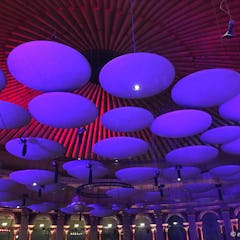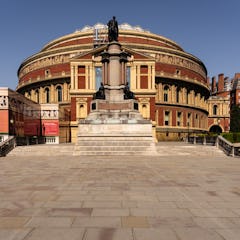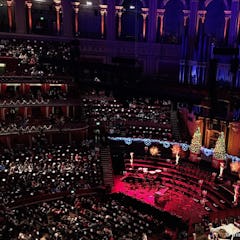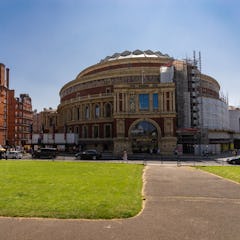History – A Tribute to a Prince and Culture
The Royal Albert Hall was opened in 1871 as a tribute to Prince Albert, consort of Queen Victoria, who was a passionate supporter of science, the arts, and education. Following the success of the 1851 Great Exhibition, he proposed the creation of several cultural institutions in the South Kensington area. The concert hall was one of these projects and was built as part of the “Albertopolis” cultural quarter. Although Prince Albert did not live to see its completion, his legacy lives on in the hall’s name and its richly adorned interior.
The hall’s foundation was part of a broader vision to make art and science accessible to the public. Since its opening, the Royal Albert Hall has served as a versatile performance venue, hosting a wide range of events, including classical music and pop concerts, sporting events, film screenings, and charity galas.
Architecture – Echoes of History Beneath the Dome
The Royal Albert Hall showcases Victorian architecture infused with Renaissance and Byzantine influences. It was designed by Captain Francis Fowke and Major-General Henry Y. D. Scott, both involved in public building projects for the British government.
Its most iconic feature is the vast domed roof, standing 41 metres high. Initially planned as an open structure, it was later enclosed with iron and glass, enhancing both the aesthetics and acoustics of the hall. A terracotta frieze encircles the exterior, featuring 69 shields in 27 unique designs.
Inside, ornate details blend with functionality. Colourful murals, velvet drapes and gilded accents create a sense of grandeur, while the hall’s shape ensures excellent views and acoustics from all seats. The venue holds around 5,200 people, and those seated in the stalls can enjoy remarkably close views of the performers.
Acoustics have always been central to the hall’s reputation. In 2001, the now-famous “acoustic mushrooms” were installed to improve sound clarity, enhancing the experience for both audience and performers.
Albert Memorial and Royal Albert Hall – A Symbolic Pair
Directly opposite the hall, on the Kensington Gardens side, stands the striking Gothic-style Albert Memorial monument. Together, the memorial and the hall form a visual and symbolic pair, with the statue facing the building as if watching over its cultural legacy. The view of the dome from behind the memorial is one of the most photographed scenes in the area.
BBC Proms – A Celebration of Classical Music
The Royal Albert Hall is especially known for the BBC Proms, a world-renowned classical music festival held annually since 1895. The Proms (short for Promenade Concerts) were created to make high-quality music accessible to the broadest possible audience. The eight-week summer season culminates in the much-loved Last Night of the Proms, known for its blend of festivity and light-heartedness.
The event attracts leading orchestras, conductors and soloists from around the world. Yet the inclusive spirit remains central: standing tickets are always available at affordable prices, preserving the festival’s open-to-all ethos. Today, the BBC Proms are considered one of the most respected classical music festivals globally, and their connection with the Royal Albert Hall is a key part of the venue’s identity.
Notable Performers and Events
Over the years, the Royal Albert Hall has hosted an extraordinary range of world-class artists, including Luciano Pavarotti, Adele, Eric Clapton, Shirley Bassey, and Led Zeppelin. The programme spans from classical symphonies to heavier rock, such as Apocalyptica in 2024, offering something for everyone. The venue has also hosted landmark speeches, memorial services and high-profile charity galas.
The variety of programming is remarkable. For example, next summer’s schedule includes six nights of piano music by Ludovico Einaudi, followed the very next day by the Strongman Classic ’25 event.
Film Concerts – Music and Storytelling Combined
Film concerts at the Royal Albert Hall have become hugely popular. These events screen classic and modern films on a giant screen while a full orchestra performs the soundtrack live. The 2025 programme includes Top Gun: Maverick (May 26), Back to the Future (October 26), and How to Train Your Dragon (November 2). These concerts create a unique fusion of cinematic storytelling and live music that complements the hall’s diverse programming.
A Musical Celebration of Christmas
The Royal Albert Hall’s festive season has become a cherished tradition for many. Throughout December, it hosts a wide range of concerts that blend musical heritage, community spirit, and artistic excellence.
One of the most beloved events is Carols at the Royal Albert Hall. In this series, the audience is invited to join in singing classic British Christmas carols, accompanied by a full orchestra and choir. Multiple performances take place over a six-day period.
Also part of the seasonal line-up is John Rutter’s Christmas Celebration, led by the composer himself, offering some of the most cherished Christmas music. In recent years, jazz singer Jamie Cullum has also brought festive cheer with his The Pianoman at Christmas concerts.
Exhibitions and Dining Options
The hall also offers exhibitions and guided tours, allowing visitors to explore its history, architecture and behind-the-scenes stories. These often include access to the Royal Box and backstage areas. Small photography displays and interactive exhibits occasionally showcase the venue’s rich event history.
Several restaurants and bars are located within the hall, catering to both concertgoers and daytime visitors. Verdi Italian Kitchen serves a relaxed Italian menu with views of the Albert Memorial. Coda by Eric Chavot offers modern brasserie-style dishes, ideal for pre-show dining for ticket holders. Numerous interval bars and cafés offer drinks and light refreshments.
If you’re seated in a private box, you can pre-order food and drinks to be served directly to your box.
Visiting Tips and Practical Info
The Royal Albert Hall is easily accessible by public transport – the nearest tube station is South Kensington, a short walk away. The venue has multiple entrances and is designed with accessibility in mind, offering wheelchair seating, lifts and hearing assistance systems.
Dress codes vary by event. Smart-casual attire is generally fine, although gala evenings may require a more formal style. Proms standing areas are typically more relaxed. It’s recommended to book tickets in advance, and last-minute availability is often posted on the Royal Albert Hall’s website.








